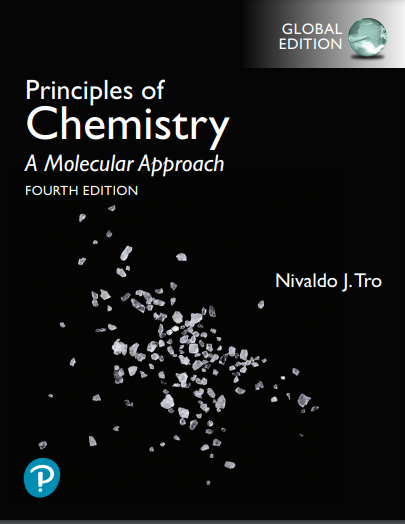
Chemistry: A Molecular Approach (4th Ed.)
N.J. Tro
1 Matter, Measurement, and Problem Solving
1.6 The Units of Measurement
1.8 Solving Chemical Problems
2 Atoms and Elements
2.6 Subatomic Particles: Protons, Neutrons, and Electrons in Atoms
2.8 Atomic Mass: The Average Mass of an Element’s Atoms
3 Molecules and Compounds
3.3 Representing Compounds: Chemical Formulas and Molecular Models
3.8 Formula Mass and the Mole Concept for Compounds
3.9 Composition of Compounds
3.10 Determining a Chemical Formula from Experimental Data
4 Chemical Reactions and Chemical Quantities
4.2 Writing and Balancing Chemical Equations
4.3 Reaction Stoichiometry: How Much Carbon Dioxide?
4.4 Stoichiometric Relationships: Limiting Reactant, Theoretical Yield, Percent Yield, and Reactant in Excess
5 Introduction to Solutions and Aqueous Reactions
5.2 Solution Concentration
5.6 Representing Aqueous Reactions: Molecular, Ionic, and Net Ionic Equations
5.9 Oxidation-Reduction Reactions
6 Gases
6.4 The Ideal Gas Law
6.5 Applications of the Ideal Gas Law: Molar Volume, Density, and Molar Mass of a Gas
6.6 Mixtures of Gases and Partial Pressures
6.7 Gases in Chemical Reactions: Stoichiometry Revisited
7 Thermochemistry
7.4 Quantifying Heat and Work
7.5 Measuring ΔE for Chemical Reactions: Constant-Volume Calorimetry
7.6 Enthalpy: The Heat Evolved in a Chemical Reaction at Constant Pressure
7.7 Constant-Pressure Calorimetry: Measuring
7.9 Determining Enthalpies of Reaction from Standard Enthalpies of Formation
10 Chemical Bonding I: The Lewis Model
10.4 Ionic Bonding: Lewis Symbols and Lattice Energies
10.5 Covalent Bonding: Lewis Structures
10.6 Electronegativity and Bond Polarity
10.7 Lewis Structures of Molecular Compounds and Polyatomic Ions
10.8 Resonance and Formal Charge
10.10 Bond Energies and Bond Lengths
11 Chemical Bonding II: Molecular Shapes, Valence Bond Theory, and Molecular Orbital Theory
11.2 VSEPR Theory: The Five Basic Shapes
11.4 VSEPR Theory: Predicting Molecular Geometries
12 Liquids, Solids, and Intermolecular Forces
12.5 Vaporization and Vapor Pressure
14 Solutions
14.6 Colligative Properties: Vapor Pressure Lowering, Freezing Point Depression, Boiling Point Elevation, and Osmotic Pressure
15 Chemical Kinetics
15.2 The Rate of a Chemical Reaction
15.3 The Rate Law: The Effect of Concentration on Reaction Rate
15.4 The Integrated Rate Law: The Dependence of Concentration on Time
15.5 The Effect of Temperature on Reaction Rate
15.6 Reaction Mechanisms
16 Chemical Equilibrium
16.4 Expressing the Equilibrium Constant in Terms of Pressure
16.6 Calculating the Equilibrium Constant from Measured Equilibrium Concentrations
16.9 Le Châtelier’s Principle: How a System at Equilibrium Responds to Disturbances
17 Acids and Bases
17.3 Definitions of Acids and Bases
17.4 Acid Strength and the Acid Ionization Constant (Ka)
18 Aqueous Ionic Equilibrium
18.2 Buffers: Solutions that Resist pH Change
18.4 Titrations and pH Curves
18.5 Solubility Equilibria and the Solubility Product Constant
19 Free Energy and Thermodynamics
19.2 Spontaneous and Nonspontaneous Processes
19.6 Gibbs Free Energy
20 Electrochemistry
20.2 Balancing Oxidation–Reduction Equations
